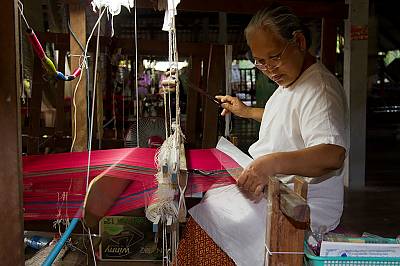- Thailand

Natural Dyeing and Silk Weaving in Surin Province, Thailand

© “Thai Silk Weaving 3 - Ban Tha Sawang” by JJ Harrison is licensed under CC BY-SA 3.0
1. ICH domains
Traditional craftsmanship
2. Short description
Jewel-toned silks made in the northeastern Surin Province of Thailand are nationally renowned for their intricate matmee/ikat patterns with rich colours achieved through the use of natural dyes, such as indigo, sticklac (a resin found on trees secreted by bugs), and other plant-based materials.
Locally, the silks’ beauty and meanings are enhanced by the roles they play in rituals and ceremonies among Surin’s Khmer, Kui and Thai-Lao communities. Woven in the region for over 1,000 years silks were traditionally key tributary gifts exchanged among kingdoms, bestowing rank and status, and embodying political and social hierarchies. Weaving patterns have been developed over time using local traditional knowledge, and such designs reveal the ethnic origin and identity of the weaver.
Today, the silks are produced in diverse configurations in Surin. While knowledge is still sometimes transmitted from one generation to the next among female family members and/or from master to apprentice, weaving and dyeing techniques can also be studied in universities, schools, and through government-sponsored programs. Some people weave and dye as their primary occupation, while others do it for supplementary income.
Further information:
The following links describe the history and contemporary production of silk in Surin:
http://virtual-exhibits.sitthichoke.info/omeka/exhibits/show/traditional-textiles-in-surin-
https://www.tatnews.org/silver-silk-villages-surin/
Link to a Royal Project supporting silk production in Tha Sawang village, Surin:
https://thailand.net.au/art-thai-silk-weaving/
Video about silk weaving in Tha Sawang, Surin:
https://www.youtube.com/watch?v=UXbES92Gm4E
3. Link with sustainable development
The many steps involved in creating a piece of silk, from planting mulberry trees and raising silkworms to tying ikat/matmee patterns and preparing the warp on the loom, allow for multiple possibilities of employment for those with the required skills. Some master weavers coordinate all stages of production within their workshops, while members of women’s weaving collectives might outsource dyeing or pattern making to specialists. Still, others carry out the entire process themselves. These approaches overlap with efforts on the part of Thai royal and state actors to broaden market access, while also ensuring that producers can create silk textiles under reasonable conditions and sell them at fair prices. For example, every weekend at Surin City Hall, the municipal government sponsors a ‘Green Market’, where mid-level weavers can sell their silks to locals and visitors. The flexibility and modularity of the production system, which allows weavers of varying economic means and/or areas of technical expertise to access suitable, stable markets, reflects the spirit of SDG 8, which promotes inclusive and sustainable economic growth, employment and decent work for all.
More information on the Thai government’s efforts to support the silk market:
http://www.nationmultimedia.com/detail/Economy/30249185
4. Questions for reflection
A significant risk related to the growing production and consumption of naturally-dyed silks in Surin is exploitation of natural resources. While natural dyes are often hailed as environmentally friendly, safe and healthy in comparison to chemical dyes, over-harvesting of dyestuffs has created shortages of some materials, such as sticklac, with ecological ramifications.
Another risk is related to commodification, and a resultant weakening of the sociocultural values associated with the silks, as described in the following article, ‘Spirit of the Loom: the Conservation and Commodification of Surin’s Textile Cultural Heritage’:
http://www.ijih.org/fileDown.down?filePath=10/dtl/7b06107b-940a-4ad0-95cb-9891e98ca4fa&fileName=08 Conserving%20Surin%E2%80%99s%20Textiles.pdf&contentType=volumeDtl&downFileId=566
What could be done at community, policy and programme levels to support the safeguarding and continued transmission of the practice of natural dyes and silk weaving among Surin’s residents?
Do you know of similar examples where specific skills related to dyes and weaving are under threat, and effective safeguarding measures were taken to ensure their safeguarding?